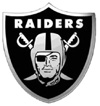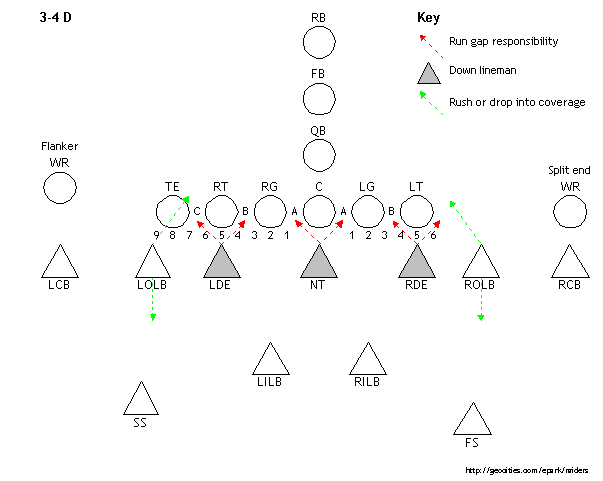The Basics of the 3-4 Defense
by Edweirdo
posted on 2005/03/15
Editor's note: this article was written in
2005; some players have moved on to new teams. But the info on the
scheme is accurate and current, and always will be. Enjoy!
With the recent success of AFC playoff teams such as the New
England Patriots, the Pittsburgh Steelers, and the San Diego
Chargers, the 3-4 D has come back in style. In 2005, 5 NFL teams
(the Broncos, Browns, Cowboys, Dolphins, and Niners) may switch to
the 3-4 as their base defense, bringing the total to 10 teams
(including the Chargers, Patriots, Raiders, Steelers, and Texans)
who favor the system. So what is the 3-4 D? This article
discusses:
- How the 3-4 defense differs from the 4-3 defense
- What are the personnel requirements for the 3-4 defense
- What are the advantages of the 3-4 defense
How the 3-4 defense differs from the 4-3 defense
The 4-3 D has the following characteristics:
- There are 4 defensive lineman (DL) and 3 linebackers (LBs)
- On plays where a LB or DB does not blitz, the pass rush is
generated by the defensive linemen. The DEs in particular must be
able to get pressure on the QB. The best/fastest pass rushing DE
typically plays at RDE and is referred to as the "rush end". The
LDE is referred to as the "base end" and must be solid against the
run, because teams often run strong-side, which is the side where
the TE is, and the TE often lines up next to the RT. The DEs play
from a 3-point stance, so they have a hand on the ground
- The SLB (strong-side LB) matches up against the TE. SLBs
typically range from 240-250 and are on the taller side for a LB.
The MLB (middle LB) plays the middle of the field and provides run
support. MLBs typically range from 240-255, although some teams get
away with an undersized MLB (e.g. the Jets' Jonathan Vilma) by
protecting him with beefy DTs. The WLB (weak-side LB) often plays
in space, has the freedom to flow to the ball, and must have good
range. WLBs are often undersized compared to the other LBs.
The 3-4 D has the following characteristics:
- There are 3 defensive lineman (DL) and 4 linebackers (LBs)
- The primary function of the DL is to protect the LBs and play
the run. Each defensive lineman is responsible for 2 gaps
- The pass rush is generated by the 3-4 OLBs. On almost every
play, 1 of the OLBs will rush the QB. The OLBs play from a 2-point
stance, so they're standing up
What are the personnel requirements for the 3-4 defense
The front 7 players in the 3-4 D are significantly different
from their counterparts in the 4-3. In a nutshell, the DL in the
3-4 are bigger than the DL in the 4-3. The 3-4 OLBs are bigger than
4-3 OLBs because they have to match up against OTs.
- 3-4 NT is the toughest position to fill. The NT is
head-up on the OC and is responsible for defending both A gaps in
the running game. He faces constant double-teams and takes a
pounding. He must have size, mental and physical toughness,
stamina, durability, lateral quickness, and good technique in terms
of playing with leverage. If the NT can not hold his ground, the
defense is very vulnerable to runs between the tackles. The
prototypical 3-4 NT is the Raiders' Ted Washington, who is a
massive 6-5 365. Washington was the key to the Patriots win over
the Panthers in the 2004 Super Bowl. Stephen Davis ran for a meager
19 yards on his first 9 carries, because Washington effectively
stuffed the middle of the line. Other quality NTs include the
Steelers' Casey Hampton (6-1 320) and the Chargers' Jamal Williams
(6-2 348)
- 3-4 OLBs are the playmakers of the D. They
get the glory of picking up sacks on the QB. They must have strong
pass rush skills and be able to drop into coverage. If the
3-4 OLBs are unable to consistently apply pressure on the QB, the D
is very vulnerable in the passing game. They tend to weigh
around 245-270, and many are former 4-3 DE/OLB "tweeners". Many 4-3
DEs are not suited to playing 3-4 OLB because they lack the ability
to play in space. The more agile 4-3 RDEs, such as the Jets' John
Abraham (6-4 256), are able to play both 4-3 DE and 3-4 OLB. Many
4-3 OLBs are not suited to playing 3-4 OLB because they lack the
pass rush skills and the ability to go toe-to-toe with an OT.
Examples of solid 3-4 OLBs are the Patriots' Willie McGinest (6-5
270) and the Steelers' Joey Porter (6-2 248)
- 3-4 DEs tend to weigh around 290-310, and many are
former 4-3 DT/DE "tweeners". They must be able to play the run
well. The 3-4 DE is responsible for the B and C gaps in the running
game and lines up in the 5-technique position, so he is head-up on
the OT. It's tough for a 3-4 DE to pick up as many sacks as a
4-3 DE, because a 3-4 DE doesn't have the freedom to go willy nilly
upfield. He has to protect the LBs in order for the 3-4 to
work. Panthers' 4-3 DE Julius Peppers said
that he didn't like playing 3-4 DE, because he felt like he was
essentially a DT. Unlike Peppers (6-6 290), most 4-3 DEs are not
suited to playing 3-4 DE, because they lack the size and ability to
hold up against the run. Examples of solid 3-4 DEs are the
Patriots' Richard Seymour (6-6 310), the Steelers' Aaron Smith (6-5
300), and the Raiders' Bobby Hamilton (6-5 285)
- 3-4 ILBs must be stout in run support. Because there are
only 3 DL to match up against 5 OL, they must be able to stack
and shed an unblocked offensive lineman in the running game.
How hard is it to play 3-4 ILB? Check out this telling
quote by All-Pro Ray Lewis, who is glad to be finished playing
3-4 ILB (the Ravens are switching from the 3-4 to the 4-3 and 46
for the 2005 season):
"We're in the 46 defense now, and finally, finally
again, I get to play football," said Lewis. "My job is not to take
on offensive linemen, but to make running backs not want to play
against me"
Examples of solid 3-4 ILBs are the former Ravens' Ed Hartwell (6-1
250) and the Raiders' Danny Clark (6-2 245)
What are the advantages of the 3-4 defense
The offense does not know which of the 2 OLBs is going to rush
the QB, as both of the OLBs are in a 2-point stance. This creates
the following advantages:
- It's harder for the offensive linemen to correctly determine
their blocking assignments before the snap and execute
- It puts more mental pressure on the QB. E.g. the Patriots did a
masterful job in disguising their D against 2004 MVP Peyton Manning
in the 2005 playoffs. Manning came unglued mentally, and his
frustration seemed to affect his performance
With the growing number of defenses running the 3-4 D, it will
be interesting to see whether its effectiveness decreases as
offenses get used to facing it.
If you have feedback / comments for this
article, email me at edweirdosraiders@gmail.com.
I may add them to this page.
Andrew Ryall (2007/05/10): While it's
not very often that a 49ers fan compliments a Raiders fan, I just
wanted to let you know that I've found your site to be a strong
resource on a couple of occasions.
When the 49ers hired Norv Turner, it was the
first time the Niners had really abandoned the West Coast Offense
of Bill Walsh in favour of the Coryell interpretation of
offense. Your site was an excellent primer on what to
expect.
I was searching for 3-4 information and came
across your site again. Your site gives an excellent rundown of the
basics of the 3-4, but that's not what I was hoping to find.
Actually, I was hoping to see the roster requirements of the 3-4
- how many DTs and LBs are typically carried by a 3-4 team. I
know there is no hard and fast rule, and teams might tip towards
one or the other (I would assume linebackers moreso, using the
Patriots of the last few years as an example).
edweirdo (2007/05/11): First off,
thanks for the feedback. The main reason I've been writing Football
101 articles on specific topics (e.g. Coryell offense, 3-4 defense)
is because of the lack of good material on the Internet.
Re: the number of players, that's a great
question.
Whether a team runs 3-4 or 4-3, they usually
carry about 14-15 for the front 7, and about 8-9 DBs, for a total
of 23-24 or so on defense (and 27-28 on O and K and P to make 53).
A 4-3 D will carry more DL than LBs, but for the 3-4 it's the
opposite.
E.g. a 3-4 might look like this:
- 2-3 NTs
- 4 DEs
- 4 OLBs
- 4 ILBs
whereas a 4-3 might look like this:
Basically a starter and a backup at each
position. The backups will typically contribute on ST and rotate in
on D to keep the D fresh. Some teams will carry an extra DB if that
player is a KR or PR.
Updated: $Date: 2009/04/22 04:33:29 $
Text and diagrams are Copyright © 2005
Edweirdo

